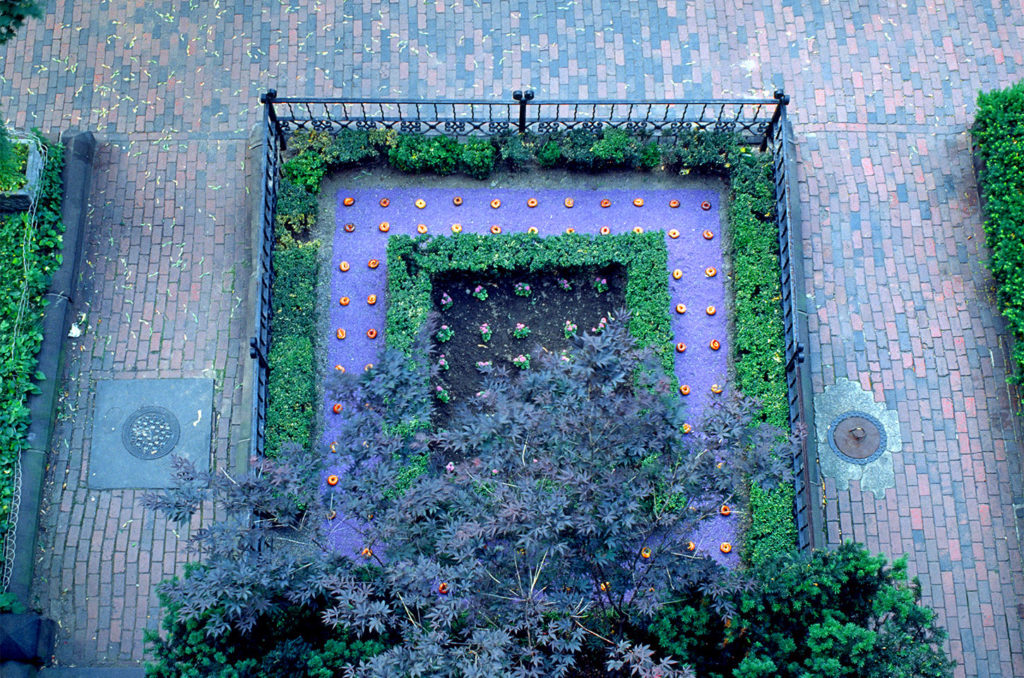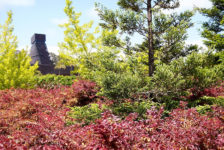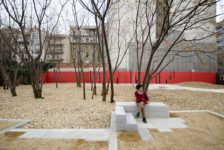As the host of America Adapts – The Climate Change Podcast, I have the honor of talking to some of the world’s leading experts in climate adaptation planning. Drought, sea level rise, extreme storm events – you name it, climate change is likely to make these problems worse. How is society going to adapt to these massive changes? Well, landscape architects think they may have some answers. I was fortunate to participate in the American Society of Landscape Architects Annual Meeting & EXPO in Los Angeles in mid-October and heard many of their stories. Listen to the podcast above sponsored by Anova Furnishings.

Image: Martha Schwartz Partners
Here’s a question: What does climate change have in common with bagels? I’ll explain. One of the more curious, and surprising, things I learned at ASLA 2017 is how in the late 1970’s, a young landscape architect (and soon to be legend) Martha Schwartz strategically placed bagels in her small house garden. This act created a sensation in landscape architecture field, since it challenged everyone to think of landscape architecture as art, not just urban planners building city parks. This story left me very encouraged that landscape architecture could be just what the adaptation universe needed to capture the public’s imagination of what challenges lie ahead in adapting to climate change.
For five days in October, with microphone and recorder in-hand, I discovered the burgeoning role of landscape architects in adaptation planning. My goal was to capture the leading voices in landscape architecture to share on my podcast. Some of my guests for the podcast episode included Brad McKee (Editor, Landscape Architecture Magazine), Martha Schwartz (Martha Schwartz Partners and Harvard University), Ellen Stewart (Landscape Architect, City of St. Paul), Kristina Hill (Professor, University of California, Berkeley); Barbara Deutsch (Landscape Architecture Foundation), and Vaughn Rinner (President, ASLA) to name just a few.

Image: ASLA / EPNAC
Some takeaways from my conversations:
- Landscape architects are doing some really innovative adaptation work, especially in regards to sea level rise planning. After an extreme storm event and rebuilding funds become available, landscape architects are helping these communities integrate climate change into their long term planning.
- Just as the bagel garden was the iconic landscape architect project for an entire generation, the Resilience by Design project is quickly becoming the de facto iconic adaptation project.
- After attending multiple presentations, it was interesting to observe that for many landscape architects, sustainability and adaptation are used interchangeably, which is problematic. There were many landscape architects who recognize the difference, but there are still landscape architects that see the two as the same. This will be problematic in the coming years as a changing climate redefines what we consider truly sustainable.
- I was able to speak to quite a few landscape architect students and emerging professionals, and they weighed in on how their university programs curricula prepared them (or did not) to address climate change. Universities are pretty uneven at this point as to what options they offer students, but you sense academic programs are ramping up quickly.
- Many of the presentations laid out tools and resources now available for landscape architects in both the public and private sector. It remains to be seen if these tools will be useful, since adaptation is a new and emerging field. In multiple communities across the country, you can see where these tools are being tested.
The main takeaway, and one that Ellen Stewart, a landscape architect working for the City of St. Paul, Minnesota, pointed out so eloquently, is that landscape architects thrive in getting people to collaborate. You might have city planners, civil engineers, and wildlife conservationists all working toward a sustainable landscape and landscape architects are at the center of many of these efforts. They are uniquely situated to take a leadership role in adaptation planning in the years ahead. It’s still early in how society decides to adapt to climate change, but landscape architects are well positioned to be part of meeting that challenge.
Lead Image Courtesy of ASLA / EPNAC
Published in Blog, Cover Story, Featured


![From Bagels to Sea Level Rise: Landscape Architects Adapt to Climate Change [Podcast]](https://land8.com/wp-content/uploads/2017/12/171021-081734-NNT-8843-XL-800x534.jpg)







